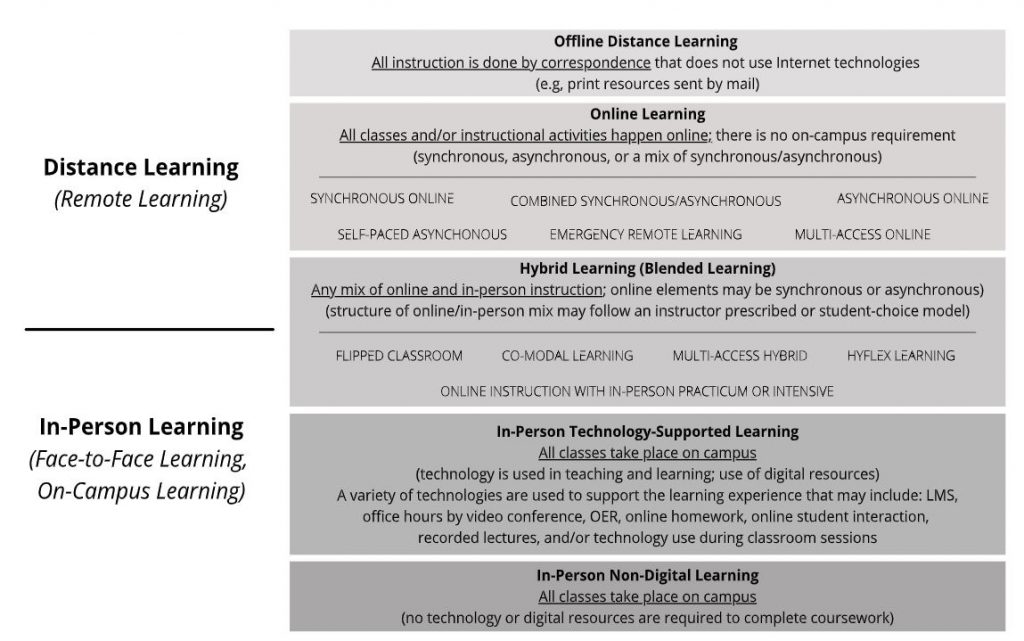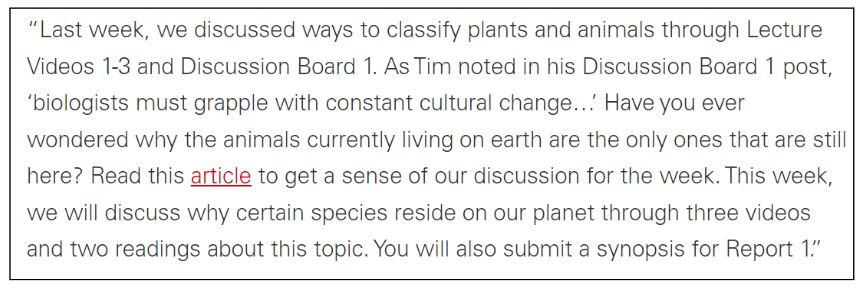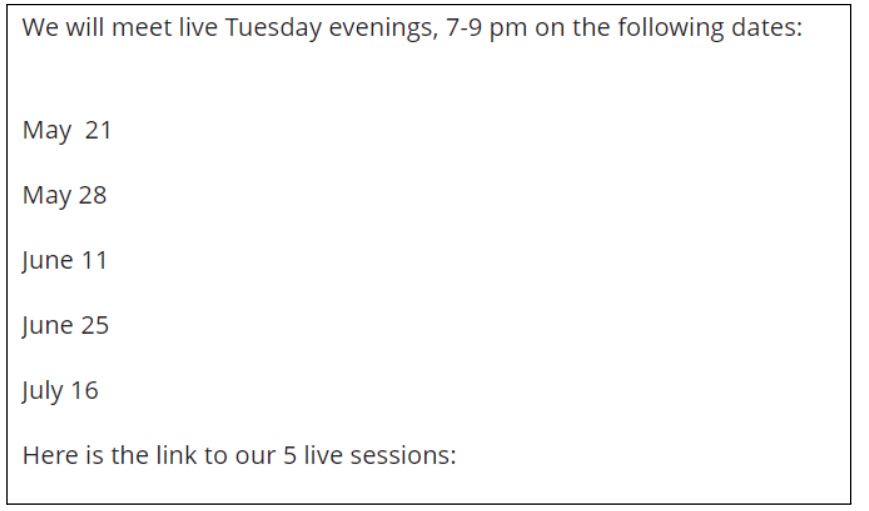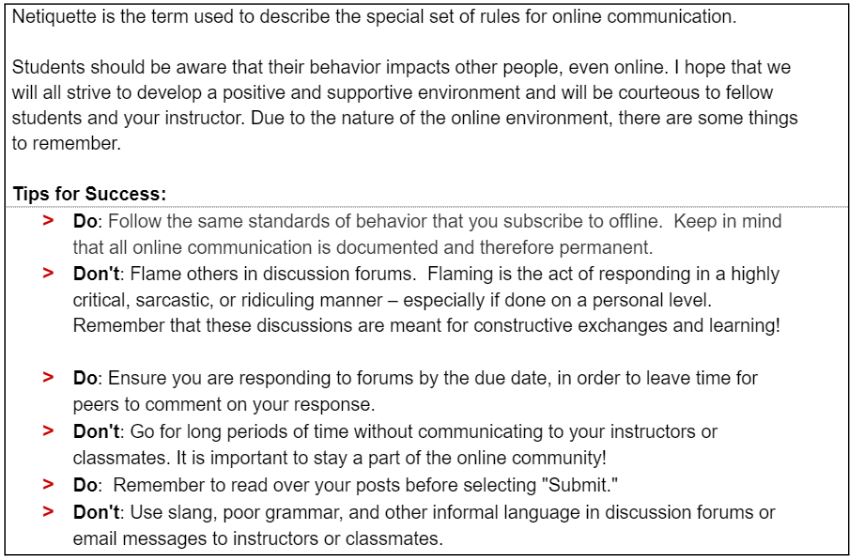Hybrid Teaching: Best Practices
At NC State, there are a number of course modalities offered, including in-person (aka face to face), hybrid (a mix of online and in-person instruction), and fully online. Research (Johnson et al., 2022) highlights the need to clearly define various modes of learning, and the diagram below does a nice job clarifying the differences:

Research suggests that hybrid learning can enhance student success (Lewis & Harrison, 2012; Rausch & Crawford, 2012; Weber & Lenon, 2007). A meta-analysis found that instruction combining online and face-to-face elements is better in terms of student outcomes than purely face-to-face instruction or purely online instruction (U.S. Department of Education).
How to Get Started
Key ways to get started include:
- Review your course from the last semester. What went well? What could be improved? Consider student evaluation comments thoroughly. This is a great reflection opportunity.
- Create a Course Map; this will allow you to plan the topics and delivery in a seamless manner.
- Ensure that all resources in Moodle are clearly written and easily accessible. Is Moodle formatting consistent? Can students find what they need easily? Consider using the Quick Start Course Shell to help make course organization and navigation easier. This DELTA video provides more information about the Quick Start Course Shell.
- Prepare yourself for student reactions. In a hybrid course, much of the work is transferred to the learners. Students may feel that a hybrid course is “more work” than other classes. A great way to counteract this perception is to highlight the advantages that a course taught this way affords them (Zepeda, 2021).
- Consider applying for a DELTA Grant or request an Instructional Consultation to get more assistance.
Best Practices
Best practices are listed below:
- To help students with the time management and self-regulation skills required for hybrid learning, consider implementing the Moodle Roadmap tool. This tool serves as a visual checklist so students can clearly see what has been completed and what is left to do.
- Clarify communication channels.
- Be explicit about asynchronous modes of communication for the days when students will not see you in-person. Will emails be responded to within 24 hours Monday through Friday? Will there be online office hours? Is there a Q&A forum in Moodle that is the best place for their questions to be posted?

- Maintain strong instructor presence
- An important aspect of a HyFlex course is students’ access to the instructor and support staff. When in-person or synchronous attendance is not required, the teaching and social presence from the Community of Inquiry Model become more important to ensure that students remain engaged and connected within the course.
- Utilize course announcements
- Weekly announcements from the instructor help establish a faculty-student connection, which leads to gains in student understanding and the overall online course experience (Jabeen, 2015). They may include reflection about previous topics, praise of student work, relevant links that can enhance comprehension, and an overview of what to expect for the next week (Tagsold, 2020).

It might be best to not take withdrawals from online courses too personally; students are more likely to withdraw from an online class rather than a face-to-face class (Lawrence & Singhania, 2004). However, when a course has been redesigned, instructors are likely to see fewer withdrawals (Temple, 2013).
Examples
Examples from hybrid courses are below:
- Create a statement for your syllabus that clarifies online learning expectations:

- Clearly express when and how you will meet synchronously:

- Provide clear Netiquette expectations:

- More examples can be found in our DELTA workshops, including:
Resources
DELTA. HyFlex Teaching: Best Practices. Teaching Resources. https://teaching-resources.delta.ncsu.edu/hyflex-teaching-best-practices/
Tagsold, J. (2015). Face-to-face, blended, or online: The impact of course delivery method on student learning. DELTA News. https://delta.ncsu.edu/news/2015/04/22/face-to-face-blended-or-online-the-impact-of-course-delivery-method-on-student-learning-2/
References
Jabeen, S. (2015). Perceived effectiveness of weekly announcements in provision of learning support to sociology students. The European Journal of Open, Distance and E-Learning, 18(1), 1-7.
Johnson, N., Seaman, J., & Poulin, R. (2022). Defining different modes of learning: Resolving confusion and contention through consensus. Online Learning Journal 26(3). https://olj.onlinelearningconsortium.org/index.php/olj/article/view/3565/1193
Lawrence, J.A. and Singhania, R.P. (2004). A Study of Teaching and Testing Strategies for a Required Statistics Course for Undergraduate Business Students. Journal of Education for Business 79(6):333-338.
Lewis, J., & Harrison, M. (2012). Online Delivery as a Course Adjunct Promotes Active Learning and Student Success. Teaching Of Psychology 39(1): 72-76. doi:10.1177/0098628311430641
Rausch, D.W. & Crawford, E.K. (2012). Cohorts, Communities of Inquiry, and Course Delivery Methods: UTC Best Practices in Learning—The Hybrid Learning Community Model. The Journal of Continuing Higher Education 60:3, 175-180. 10.1080/07377363.2013.722428
Tagsold, J. (2020). Perk up your course announcements: 5 tips for enhancing the faculty-student connection. DELTA News. Retrieved from https://delta.ncsu.edu/news/2020/07/21/perk-up-your-course-announcements-5-tips-for-enhancing-the-faculty-student-connection/
Temple, T. (2013, February). Focusing on Student Success: Assessment of Learning Outcomes in Blended Environments. Paper presented at the Lilly Conference on College and University Teaching, Greensboro, NC.
U.S. Department of Education, Office of Planning, Evaluation, and Policy Development (2010). Evaluation of Evidence-Based Practices in Online Learning: A Meta-Analysis and Review of Online Learning Studies, Washington, D.C.
Weber, J. M. and Lennon, R. (2007). Multi-Course Comparison of Traditional versus Web-based Course Delivery Systems. The Journal of Educators Online 4(2):1-19.
Zepeda, L. (2021). Ten useful tips for teaching a hybrid course for the first time. Times Higher Education. Retrieved from https://www.timeshighereducation.com/campus/ten-useful-tips-teaching-hybrid-course-first-time

